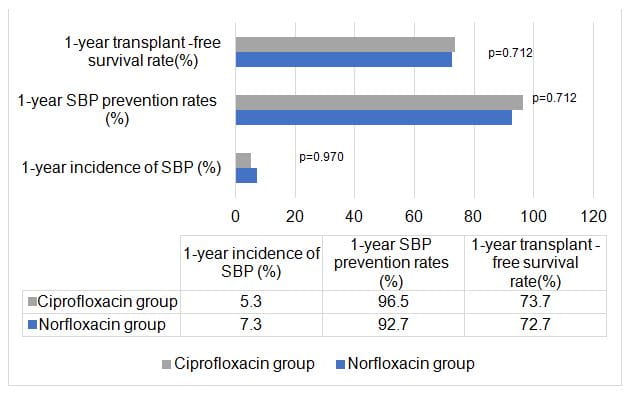Efficacy of Daily Norfloxacin vs. Weekly Ciprofloxacin Prophylaxis for to Spontaneous Bacterial Peritonitis Prevention
Introduction
Spontaneous bacterial peritonitis (SBP) is a frequent and life-threatening complication in liver cirrhosis patients with ascites. It is mainly caused by increased bacterial translocation from the intestine. Oral norfloxacin 400 mg per day is recommended as a standard regimen for the prevention of SBP in patients with liver cirrhosis. Ciprofloxacin 750 mg per week has previously shown to be effective and convenient.
Aim
To compare the efficacy of once-weekly ciprofloxacin with that of daily norfloxacin for the prevention of SBP
Patient Profile
- Liver cirrhosis patients with ascites
- Aged between 20–75 years old
- Ascitic protein ≤1.5 g/dL or the presence of a history of SBP
- Ascitic polymorphonucleated cell count needed to be <250/mm3
Methods
- An open-label randomized controlled trial
- The primary endpoint was the prevention rate and the incidence of SBP in 1 year
- Secondary endpoints included transplant-free survival, liver-related events (variceal bleeding, hepatic encephalopathy, hepatorenal syndrome, and newly developed HCC), and the infections other than SBP, factors associated with survival
Results
Baseline characteristics including age, gender, underlying medical illness, etiology of liver disease, alcohol consumption status, HCC, Child-Pugh score, MELD score, MELDNa score, laboratory findings, and frequency of complications of liver cirrhosis were not different between the groups
Primary Outcome
- Weekly ciprofloxacin was not inferior to daily norfloxacin for the prevention of SBP in patients who did not have a history of SBP
- In patients who did not have a previous history of SBP,
- The incidence of SBP was not different between the groups (norfloxacin group=2.0% vs ciprofloxacin group=4.2%, P = 0.613).
- The 1-year SBP prevention rates were 98.0% for the norfloxacin group and 95.8% for the ciprofloxacin group (P = 0.613)
- 25 patients died or received liver transplantation (12 in the norfloxacin group and 13 in the ciprofloxacin group).
- The transplant-free survival rates (76.0% vs. 72.9%, respectively, P = 0.726) and probability of cumulative survival rates (P = 0.746) were not different between the groups
Secondary Endpoints
- Incidence of infectious complication, hepatorenal syndrome, hepatic encephalopathy, and variceal bleeding rates was not significantly different (all P = ns)
- One patient had Clostridium difficile infection
- Variceal bleeding developed in 7 patients
- hepatic encephalopathy in 17 patients
- Hepatorenal syndrome in 5 patients
- New hepatocellular carcinoma in 4 patients
- The factors related to survival were models representing an underlying liver function
- In multivariable analysis, the Child–Pugh score, MELD, MELD-Na, bilirubin, and BUN were significant factors for survival
Conclusion
- The study demonstrated that once-weekly administration of ciprofloxacin was not inferior to once-daily norfloxacin which is a current standard therapy for prevention of SBP in cirrhotic patients with ascites
- Once weekly ciprofloxacin would be a good alternative to daily norfloxacin for the prevention of SBP in liver cirrhosis patients with ascites and low ascitic protein level if we considered cost effectiveness, availability, and drug compliance
Reference
Am J Gastroenterol. 2018;113(8):1167-1176











